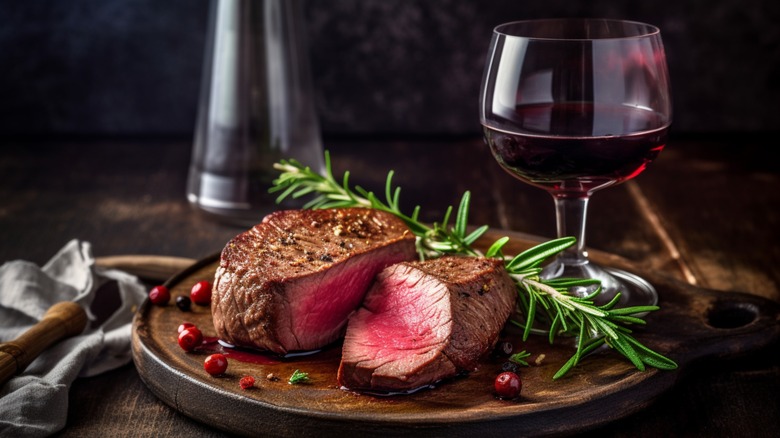What Role Do Tannins Play In Wine?
Some of the descriptors used to describe the tannic qualities of wine, like "grippy," "velvety," or "angular" don't make a lot of sense until you understand their underlying function. Tannins — found in grape skins, as well as seeds and stems, and to a much smaller extent, flesh – provide complexity and improve the mouthfeel of wine. Generally, tannins are what help create that drying or puckering sensation, but this is not to be confused with the tartness of acidity or the dryness attributed to low-sugar wines.
Like sulfites, you'll find tannins in all wines, but red wines contain the most, particularly those where the grapes had thick skins, or the grape skins are included in the winemaking process beyond extraction (think Shiraz or petite Syrah). Lighter skin-contact wines contain far fewer tannins, and while varieties sit on a spectrum, whites have roughly one-tenth the number of tannins than deep reds. Oak-aged wines like some chardonnay (which goes great with white pizza, by the way) are also high in tannins because the oak barrels impart them as well.
Tannins add structure to wine and complement food
The basic characteristics of wine, including sugar, acid, alcohol, body, and tannins are what make each distinctive. Turning the volume up and down on each of these affects how a wine tastes and feels, so think of tannins like turning up the bass on your stereo — it enriches the overall wine-drinking experience and adds structure. Although "structure" might sound like another abstract descriptor, it refers to the mouthfeel of wine and is impacted by how tannins work on a molecular level.
As tannins age or are exposed to oxygen, they polymerize, making big chains of tannins, which take the compounds from tasting bitter to more astringent. Both bitterness and astringency can work to complement food, with bitterness balancing out rich dishes and astringency cleansing the palate to bring out more flavors. This is why a glass of Cabernet Sauvignon (whether from the old or new world of wine) tastes so good with a juicy ribeye steak or a bowl of spaghetti bolognese is made more delicious with chianti.
Tannins may come with health benefits too
Aside from their role in taste, tannins have some interesting and beneficial effects on overall health. This is primarily due to their classification as polyphenols, a type of plant compound well-known for its antioxidant and anti-inflammatory properties. Tannins are just one of the polyphenols in wine, which also include more widely studied anthocyanins and resveratrol, but since all of these polyphenols are found primarily in wine skins, and tannic wines tend to have more skin contact, these wines generally have higher levels of polyphenols too.
With this in mind, the age-old advice to drink red wine for health makes more sense. Although it can be difficult to determine whether the health benefits of red wine stem from alcohol, polyphenols, or both, research from the American Heart Association and Harvard Health suggest that moderate red wine consumption can protect against cardiovascular disease, raise levels of HDL cholesterol (aka good cholesterol), and reduce prostate cancer risk. Red wine has also been shown to increase levels of beneficial gut bacteria like Akkermansia muciniphilia and Bifidobacterium.
However, don't go glugging down bottles of red wine based just on this research. There tends to be a sweet spot with red wine, with moderate consumption (no more than 7 drinks per week for women, 14 for men), not heavy consumption, associated with better health outcomes. There are also plenty of other ways to get polyphenols in your diet without the risks of alcohol, including tea, dark chocolate, almonds, pomegranates, grapes, and dark chocolate.


